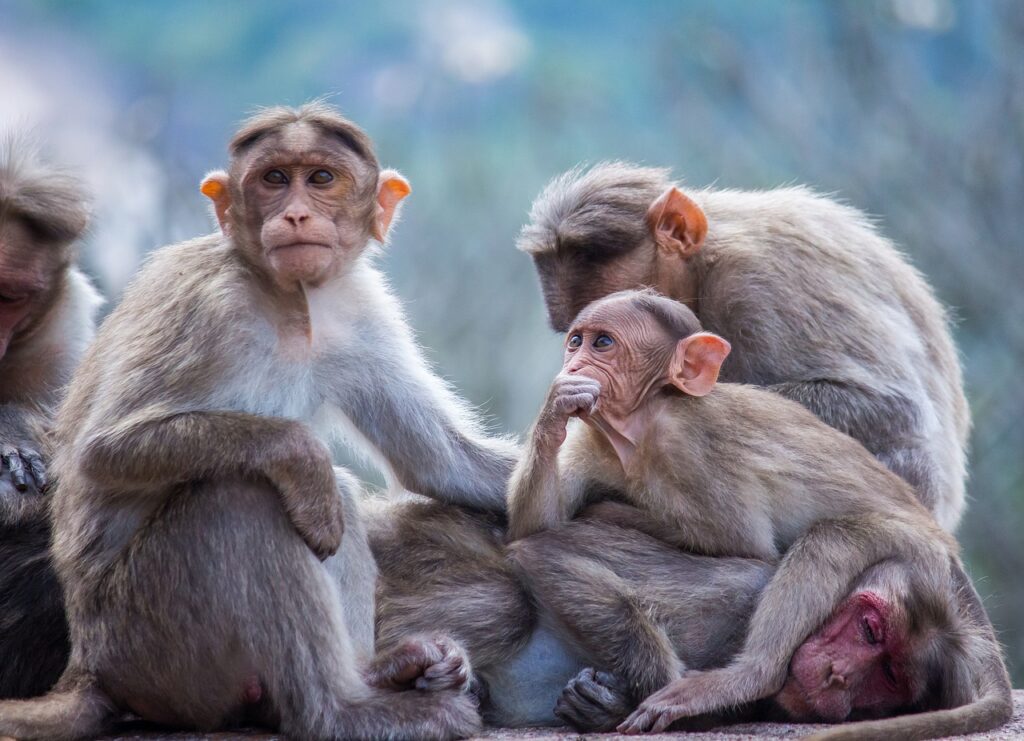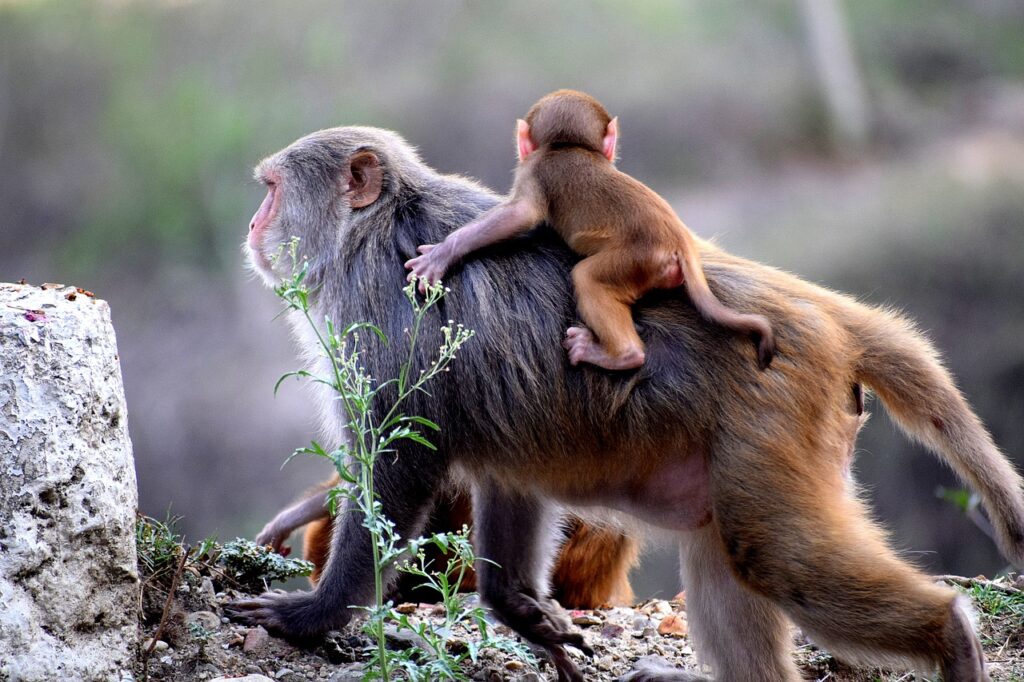
Monkeys are among the most captivating animals on our planet. With their playful behavior, diverse species, and uncanny similarities to humans, they’ve captured the imagination of scientists, storytellers, and animal lovers alike. But what do we really know about these intelligent creatures? In this article, we’ll explore the rich and varied world of monkeys, diving into their habitats, behaviors, social structures, and more. Whether you’re a casual observer or a budding primatologist, there’s something here for everyone.
What Are Monkeys?
Monkeys are primates, a group that also includes apes and humans. They are divided into two major categories:
- Old World Monkeys (Cercopithecoidea): Found in Africa and Asia, these monkeys typically have narrow noses and non-prehensile tails. Examples include baboons, macaques, and colobus monkeys.
- New World Monkeys (Platyrrhines): Native to Central and South America, these species often have broad noses and prehensile tails, which they use like a fifth limb. Examples include howler monkeys, capuchins, and spider monkeys.
One striking difference between the two groups is their locomotion. Old World monkeys tend to walk on all fours and spend significant time on the ground, while New World monkeys are more arboreal, swinging from branch to branch in the canopy.

Habitats and Distribution
Monkeys are incredibly adaptable and can be found in various habitats, including:
- Rainforests: New World monkeys like spider monkeys thrive in lush, tropical rainforests where they feast on fruits, nuts, and insects.
- Savannas and Grasslands: Old World species like baboons often inhabit open landscapes, foraging for roots and small animals.
- Mountains: Some monkeys, such as the golden snub-nosed monkey, survive in high-altitude forests with freezing temperatures.
- Urban Areas: Certain species, like rhesus macaques, have adapted to city life, scavenging for food and interacting with humans.
Each habitat influences a monkey’s diet, behavior, and social structure, making them one of the most diverse groups of mammals on Earth.
Monkey Behavior: More Than Just Playful Antics
Monkeys are famous for their energetic and playful nature, but there’s much more to their behavior than meets the eye. Here’s a closer look at what makes them so intriguing:
Social Structures
Monkeys are highly social animals, often living in large groups called troops. These groups can range from a handful of individuals to over a hundred, depending on the species. Social hierarchies are common, with dominant males or females leading the group.
- Matrilineal Bonds: In species like macaques, females form close-knit groups where sisters, mothers, and daughters stick together for life.
- Alpha Leadership: Many Old World monkeys, such as baboons, have a clear alpha male who leads the troop and mates with most of the females.
- Cooperation and Altruism: Monkeys often groom each other to strengthen bonds, reduce stress, and keep parasites at bay.
Communication
Monkeys have a rich repertoire of vocalizations, facial expressions, and body language to communicate:
- Alarm Calls: Vervet monkeys use specific sounds to warn about different predators, such as leopards or snakes.
- Facial Expressions: A toothy grin in a monkey is often a sign of aggression rather than happiness.
- Tool Use: Capuchins have been observed using sticks to extract insects from logs, showcasing their problem-solving abilities.

What Do Monkeys Eat?
Monkeys are omnivorous, meaning their diet includes both plants and animals. However, their exact preferences vary widely:
- Fruits and Nuts: A staple for many species, providing essential vitamins and energy.
- Leaves and Flowers: Colobus monkeys have a specialized stomach to digest tough plant material.
- Insects and Small Animals: Marmosets and tamarins often eat insects, while some larger monkeys occasionally hunt small mammals or birds.
Seasonal changes and habitat conditions can significantly impact their food choices, making adaptability a crucial survival trait.
Monkeys and Their Intelligence
It’s no secret that monkeys are intelligent. Their cognitive abilities are a major reason they’re often studied to understand human evolution.
Problem-Solving Skills
Capuchin monkeys, for instance, are known for their ability to use tools. In one study, they were observed cracking open nuts using rocks—a behavior that requires both planning and dexterity.
Memory and Learning
Monkeys can remember complex routes through forests and even recognize themselves in mirrors, a trait that indicates self-awareness.
Cultural Behaviors
Some troops exhibit behaviors unique to their group, such as washing sweet potatoes in water or playing specific games. These cultural differences suggest a level of learning and imitation not commonly seen in other animals.
Threats to Monkey Populations
While monkeys are widespread, many species face significant threats:
Habitat Destruction
Deforestation for agriculture, logging, and urban development is destroying the homes of countless monkeys. Rainforest species are particularly vulnerable, as their habitats are often targeted for palm oil plantations.
Hunting and Poaching
In some regions, monkeys are hunted for their meat or captured for the illegal pet trade. Species like the endangered golden lion tamarin have been pushed to the brink due to these practices.
Climate Change
Rising temperatures and changing weather patterns disrupt food sources and breeding cycles, making it harder for monkeys to survive in their natural habitats.

How Can We Help?
Protecting monkeys and their habitats requires collective effort. Here’s how you can contribute:
- Support Conservation Programs: Organizations like the Jane Goodall Institute and World Wildlife Fund work tirelessly to protect primates.
- Reduce Your Carbon Footprint: Climate change affects all ecosystems. By using renewable energy and reducing waste, you’re helping wildlife too.
- Avoid Products Linked to Deforestation: Look for sustainable certifications on products like paper and palm oil.
- Educate Others: Sharing knowledge about monkey conservation can inspire more people to take action.
Fun Monkey Facts
Let’s wrap up with some fascinating tidbits about monkeys:
- Longest Tail: The black spider monkey has a tail that can grow up to 32 inches long, making it longer than its body!
- Quick Learners: Monkeys can be trained to assist people with disabilities, much like service dogs.
- Oldest Monkey Fossils: The oldest known monkey fossils date back over 20 million years.
- Night Owls: Unlike most monkeys, the owl monkey is nocturnal, meaning it’s active at night.
- Record Jumper: Some monkeys can leap distances of over 30 feet in a single bound!
Monkeys are more than just the mischievous creatures we see in zoos or movies. They are complex, intelligent beings with intricate social lives and critical roles in their ecosystems. By learning more about them and supporting conservation efforts, we can ensure these amazing animals continue to thrive for generations to come.
Bring the jungle to life for your little adventurer with this plush animal set – roaring fun and cuddly companions await! 🦁🐵🐘 ==> Click here!